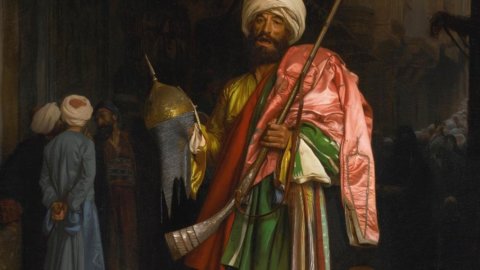The sale also features a substantial selection of works by the core group of painters who paved the way for French Impressionism, including six paintings by Jean-Baptiste-Camille Corot Jean-Léon Gérôme, Marchand ambulant au Caire, oil on canvas, 1869 (est. $700,000/1 million) Jules Bastien-Lepage, Marchande De Fleurs À Londres, oil on canvas, 1882 (est. $500/700,000) and significant works by Gustave Courbet, Johan-Barthold Jongkind and Jean-François Millet.
The exhibition is on view at Sotheby’s New York headquarters 1 – 6 May 2015 ahead of the 7 May auction which coincides with Impressionist & Modern Art Week. Both of the cover lots, Jules Bastien-Lepage’s Marchande de fleurs à Londres ($500,000/700,000) and Jean-Léon Gerome’s Orientalist masterpiece Marchand ambulant Au Caire ($700,000/1 million), depict contemporary street scenes from the artist’s travels. Painted in 1882, Bastien-Lepage’s Marchande de fleurs à Londres is one of only two paintings of working-class subjects he completed in London, the other being Le petit cireur de bottes (1882, Musée des Arts Decoratifs, Paris).
While the painting shows some resemblance to Édouard Manet’s Bar at the Folies-Bergère (1881-82, The Courtland Institute, London), exhibited at the Salon of the same year, it primarily recalls Manet’s Street Singer of 1862 (Museum of Fine Arts, Boston). Bastien-Lepage undoubtedly knew this earlier work, capturing the resignation of his subject with the same sense of realism and empathy.
In 1869, when Marchand ambulant au Caire was painted, Gérôme had recently returned from a twelve-week tour of the Middle East and was at the height of his popularity and technical virtuosity. Gérôme first visited Egypt in 1856 and traveled to the country seven times over the course of his career and the country and its people inspired some of his most celebrated compositions. A nearly photographic representation of Egyptian daily life, Marchand ambulant au Caire features many of Gérôme’s favorite possessions acquired during his travels, and draws from his extensive library of figure studies and architectural sketches.
The present work joins a series of paintings depicting Middle Eastern bazaars and merchants also referred to as his “merchant series,” which includes the Brooklyn Museum’s The Carpet Merchant of Cairo, painted the same year. Also from 1869 is Gérôme’s iconic Bashi-Bazouk, in the collection of The Metropolitan Museum of Art in New York, which portrays a Mamluk guard wearing the same distinctive pink satin coat featured in the present work.





